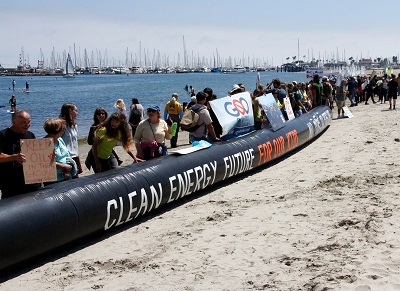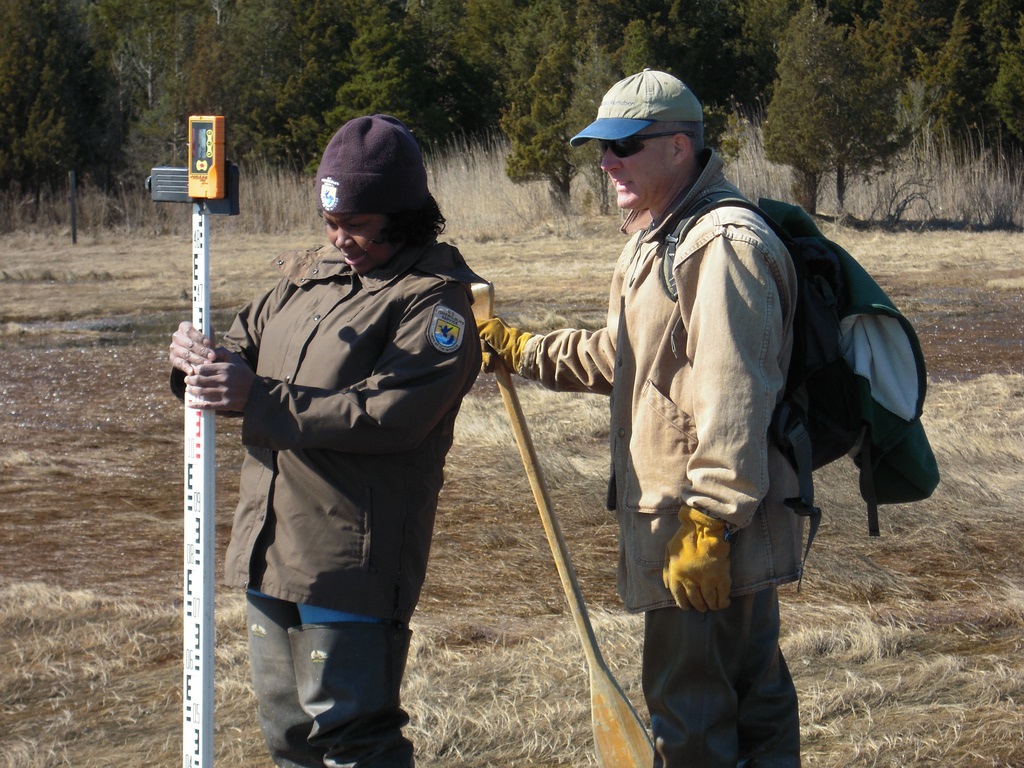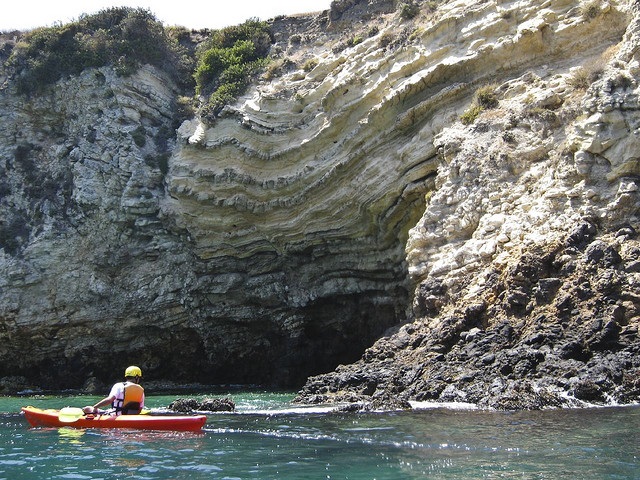
Highlights from the Legislature's First Six Months
Coastal Commission Releases "Sea Level Rise Policy Guidance"
Island Hopping in the Channel Islands
Highlights from the Legislature's First Six Months
By Kathryn Phillips
The first key voting period for this new legislature has just completed and now we have a better sense about how the environment is likely to fare this year and next.
The verdict so far: So far, so good.
Important bills that would increase renewable energy in the state by setting new 2030 targets for electricity providers and the amount of renewable energy that they need to include in their retail sales passed in both houses. However, neither of the bills, Senate Bill 350 (de Leon) and Assembly Bill 645 (Williams and Rendon), is regarded as being in final form. Most anticipate they will each go through negotiated changes as they move through the opposite house and the authors work to ensure their successful passage through both houses.
A bill that would close a nagging legal loophole that allows new offshore oil drilling in California under certain circumstances also passed in the Senate without a vote to spare, despite oil industry opposition. The bill, Senate Bill 788 (McGuire), would ensure that one of the most biologically rich areas off the Santa Barbara coast would no longer be threatened by an oil company’s plans to do horizontal drilling into the sea from Vandenberg Air Force Base.
A bill very similar to SB 788 failed in the Assembly last year. However, that was before Californians were reminded recently by a spill onto Refugio State Beach of the horrible environmental, public health and economic impacts of ocean oil spills. The bill has a fighting chance in the Assembly this year.
However two other important bills that the oil industry targeted for failure, Senate Bill 454 (Allen) and Assembly Bill 356 (Williams), fell well short of the votes needed to clear their respective houses. And another, Senate Bill 545 (Jackson), didn’t make it out of committee and didn’t get the chance for a floor vote. All of these bills would have tightened the reins on the oil industry and the key permitting agency, the Division of Oil Gas and Geothermal Resources, to prevent ongoing pollution of groundwater and other resources by the industry.
Sierra Club California tracks hundreds of bills each year. The positions we take on legislation are established by a volunteer legislative committee whose expert members are appointed by our volunteer executive committee. To help volunteers and supporters who like to follow key environmental policy at the Capitol closely, we produce a list of priority bills that you can find on our website here.
If you want to know whether we are covering a bill that isn’t on the list and what our position on the bill is, you can contact Meg Gunderson.
If you want more information about any particular bill, you can find that by going into the state website for legislation at http://www.leginfo.ca.gov.
Finally, if you want timely updates about legislation, regulation and other activities in which Sierra Club California is involved, join our CalActivist listserv.
 Coastal Commission Releases "Sea Level Rise Policy Guidance"
Coastal Commission Releases "Sea Level Rise Policy Guidance"
By Michael Thornton
The California Coastal Commission has released a revised “Sea Level Rise Policy Guidance” document for public review. The Commission received and reviewed hundreds of comments from individuals and organizations, including Sierra Club California, on a first draft at the end of 2014.
In the current document’s opening pages, California’s Coastal Commission sounds a warning about the urgency of addressing sea level rise. “Climate change is happening now. Rapidly melting ice caps, rising sea levels, floods, extreme heat waves, droughts, and fires are just a few of the effects of climate change. These effects are having profound impacts on our coast and are changing coastal management planning and decision making at global, national, state, regional, local, and individual scales.”
The scale of the potential environmental, economic and social impacts of sea level rise in California is massive, according to the document. Slightly more than 21 million people live in California’s coastal counties, generating a $40 billion coastal and ocean economy, and holding an estimated $100 billion worth of property. This property includes seven wastewater treatment plants, commercial fishery facilities, marine terminals, Coastal Highway One, 14 power plants, residential homes, and other important development and infrastructure. All are at risk of inundation during a large flood event by the turn of the next century.
In its comment letters, Sierra Club California has urged the Coastal Commission to take a proactive and systematic approach to addressing the myriad issues that are likely to result from sea level rise. We’ve emphasized that the key to success will lay not only in creating guidance for local and regional development, but also in the timely adoption and implementation of forward-looking policies and strategies.
Another area that Sierra Club California focused on in our comments, and that resulted in additions to the document, was sea level rise’s environmental and social justice challenges and the need to make special efforts to ensure that these challenges are addressed in coastal planning processes and decisions.
As we stated, "Social equity and environmental justice can be a bottom line value of, and woven throughout, the entire fabric of the guidance. The risks and rewards of SLR planning and adaptation must be distributed along equitable lines. A favored group or groups cannot be provided with an inequitable share of SLR protection/benefits at the expense of others who are less powerful and/or affluent.”
In addition we told the Commission, "While education, outreach, and engagement on SLR need to be aimed at traditional audiences such as local and regional decision-makers, planning departments, community leaders, development, and business interests, there must be special emphasis and effort made to target the most vulnerable coastal populations and communities. Outreach and communication efforts for these populations and communities must be designed and implemented so that they are effective. These efforts must be made in ways that are sensitive to the cultural, language, and economic realities of these populations and communities."
We’re pleased that the California Coastal Commission and a variety of state agencies, and local jurisdictions are working to address the serious problems being posed by sea level rise along our coastline.
The Coastal Commission is accepting public comment on the current version of the guidance document until early August. Once completed the “Sea Level Rise Policy Guidance” document should be a useful tool in helping to guide smart and forward-looking planning in California’s coastal communities.
Island Hopping in the Channel Islands
By Meg Gunderson
This summer and fall, you can experience one of the most unique parks in the country on a three-day, three-island, live-aboard tour, including hiking and kayaking, with Sierra Club members and a park naturalist.
And your tour benefits the political work of Sierra Club California, the environment's strongest voice in the State Capitol. While you are floating about the islands, you will be helping to protect them and other natural resources found only in California.
The Channel Islands are only accessible by boat or plane. Within view of Ventura and Santa Barbara, one of California’s most unique environments is part of Channel Islands National Park and National Marine Sanctuary.
All cruises depart from Santa Barbara, California. The cost, $615, includes an assigned bunk, all meals, snacks, and beverages plus the services of a ranger/naturalist who will travel along to help lead hikes, point out items of interest and give evening programs.
Click here for a recent trip report by Sierra Club member Cheryl Weiden.
Room is still available on these trips:
June 14-16
August 24-26
September 27-29
October 25-27
To reserve space, send a $100 check, written out to Sierra Club, to leader Joan Jones Holtz, 11826 The Wye St., El Monte, CA 91732. For more information contact leader: 626-443-0706; jholtzhln@aol.com

When you go solar with a company that is a trusted Sierra Club partner, you get a special discount and at the same time, send funds back to Sierra Club California. It's a win-win-win!
Call 855-438-7860 to talk to Sungevity about this offer.
Thank you for being a part of our work! You may securely donate online or by sending a check to Sierra Club California at 909 12th Street, Suite 202, Sacramento, CA 95814.

